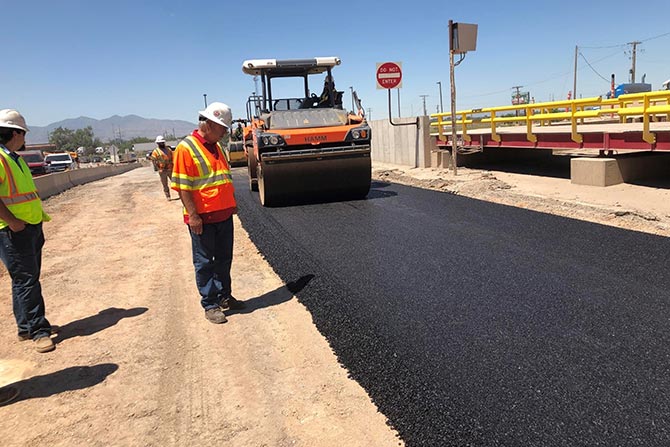As the climate changes, extreme weather events can impact the performance and resiliency of flexible pavement systems. Traditional pavement design relies on historical (stationary) climate data to design and predict future pavement performance, thus changing climate may lead to under-designed pavements and constrained budgets for maintenance and rehabilitation (M&R). There are three common approaches to incorporate climate change impacts into the decision-making process to help design, build and maintain resilient pavements. The three approaches include scenario-based (top-down), asset-based (bottom-up) and hybrid (a combination of both). Regardless of which approach is selected, stakeholder involvement and incorporating future climate projections into the analysis are crucial steps.
A scenario-based approach begins with choosing two or more future climate change scenarios. This approach can be useful in identifying potential future pavement-life reductions and promoting climate resilience through enhanced pavement design. In comparison, the asset-based approach seeks to evaluate the pavement’s sensitivity to plausible future climate or environmental conditions while designing for future traffic loads. A key difference between the two approaches is that the asset-based approach provides a more complete picture of the pavement’s response to incremental environmental change, and the scenario-based approach provides information on the timing of critical environmental change to inform design and M&R. The hybrid approach is when an asset’s response to incremental environmental changes is investigated first and then the timing of critical pavement impacts for budgeting and planning purposes is predicted.
A case study example of the hybrid adaptation approach was performed for a regional connector in coastal New Hampshire (Knott et al., 2019). First, the pavement’s response to loading with incremental temperature and groundwater rise is investigated using pavement climate sensitivity catalogs. A climate sensitivity catalog is a tool to assess an asset’s response to incremental changes in two or three climate parameters like temperature and groundwater levels, or temperature and precipitation, etc. For example, in this case study, pavement performance was explored as a function of incremental changes in temperature on one axis and incremental changes in groundwater levels on the other axis.
The next step is to select different adaptation pathways for additional performance and cost analysis using three emissions and sea-level rise scenarios. An adaptation pathway is a prescribed series of adaptation actions to be taken over time. An adaptation plan consists of several adaptation pathways with tipping points that mark where you can change from one adaptation pathway to another in response to changing climate scenarios, new materials, substantial changes in traffic volume, continuous surface-water flooding as with sea-level rise, or other. In this case study, the adaptation pathways are a series of adaptation actions including asphalt overlays and/or increasing the thickness of the granular base course as rehabilitation alternatives to maintain 85% reliability of the pavement structure for the period 2020-2080 (Knott et al., 2019). The marker “X” indicates when AC overlays should be applied and bullseye symbols indicate when a transfer to another pathway can occur, if necessary. The selection of an adaptation pathway is dependent on funding and construction-related constraints.
Many organizations have begun to plan for climate change by identifying vulnerable transportation assets and including climate change in the planning process. An important step toward designing resilient pavement systems is to know how environmental factors such as increasing temperatures, precipitation and sea level will impact pavement infrastructure and how to modify design practices. Now more than ever, there is a critical need to include accurate and reliable short- and long-term climate information in pavement design and M&R decision process. All three approaches mentioned herein may be used to account for climate change using future climate projection data. The selection of a given approach should be aligned with the goal and scope of the study and agreed upon by all stakeholders. To learn more, visit www.asphaltpavement.org/resilience.
For more information, NAPA recommends the following references:
Haslett, K. E., Knott, J. F., Stoner, A. M., Sias, J. E., Dave, E. V., Jacobs, J. M., Mo, W., & Hayhoe, K. (2021). Climate change impacts on flexible pavement design and rehabilitation practices. Road Materials and Pavement Design, 22(9), 2098-2112.
Knott, J. F., Jacobs, J. M., Sias, J. E., Kirshen, P., & Dave, E. V. (2019). A Framework for Introducing Climate-Change Adaptation in Pavement Management. Sustainability. 11(16), 4382.
To read the original article by NAPA, please click the link.
https://www.driveasphalt.org/uploads/documents/NAPA_Case_Studay_Resilience_Prepare_Approaches.pdf









